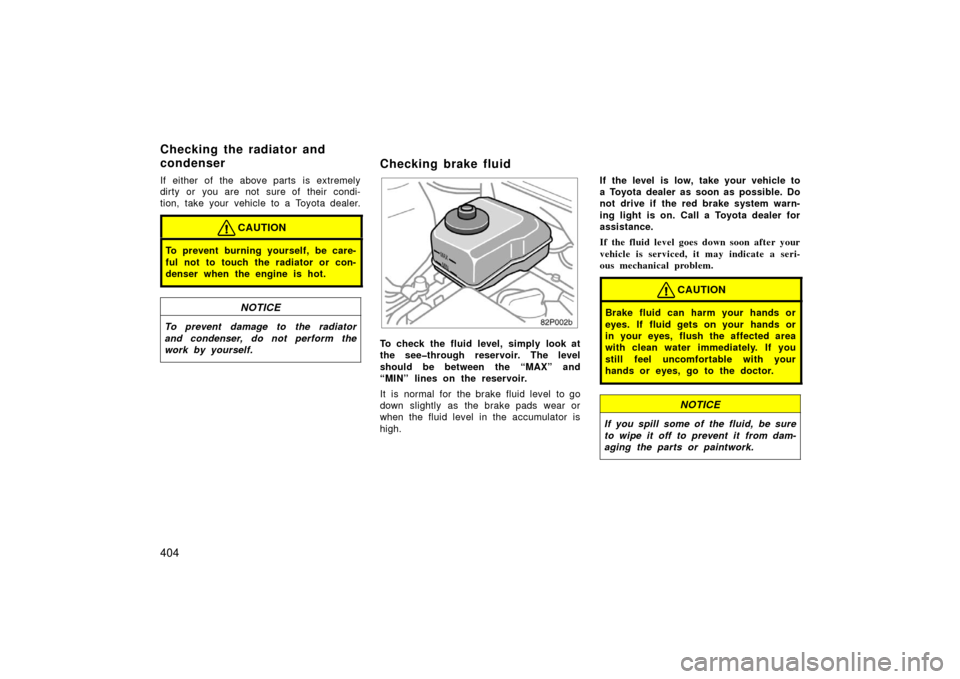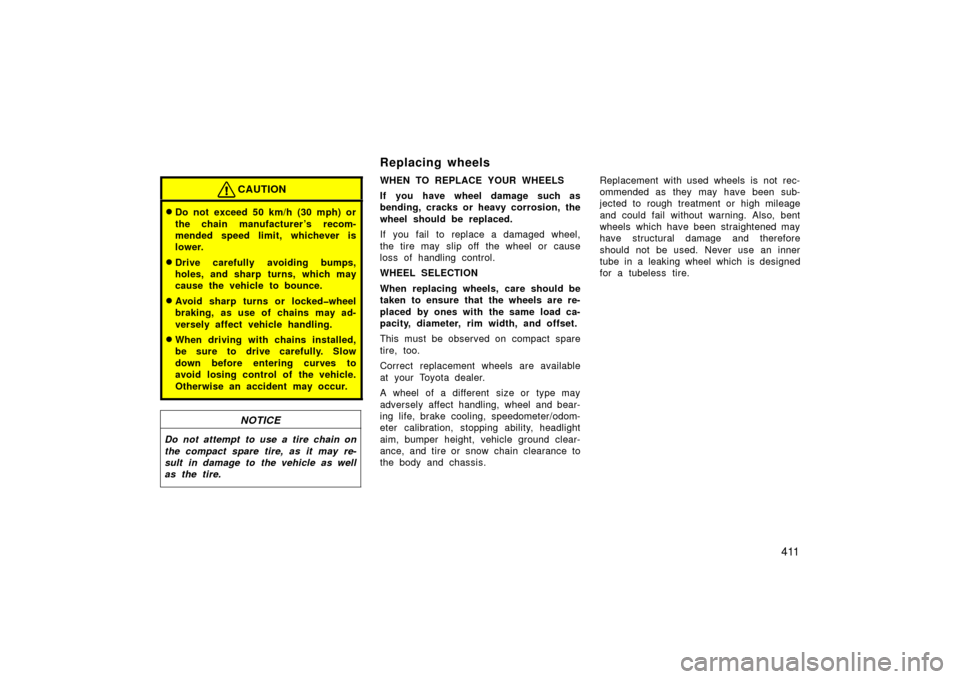Page 397 of 455

397
Parts and tools
Here is a list of parts and tools you will
need to perform do−it−yourself mainte-
nance. Remember all Toyota parts are de-
signed in metric sizes, so your tools must
be metric.
CHECKING THE ENGINE OIL LEVEL
Parts (if level is low):
�Engine oil ILSAC multigrade having vis-
cosity proper for your climate
Tools:
�Rag or paper towel
�Funnel (only for adding oil)
CHECKING THE COOLANT LEVEL
Parts (if level is low):
�“Toyota Super Long Life Coolant” or
similar high quality ethylene glycol
based non− silicate, non −amine, non− ni-
trite, and non −borate coolant with long −
life hybrid organic acid technology.
“Toyota Super Long Life Coolant” is a
mixture of 50% coolant and 50% deion-
ized water (for the U.S.A.) or 55%
coolant and 45% deionized water (for
Canada).
Tools:
�Funnel (only for adding coolant) CHECKING BRAKE FLUID
Parts (if level is low):
�SAE J1703 or FMVSS No.116 DOT 3
brake fluid
Tools:
�Rag or paper towel
�Funnel (only for adding fluid)
CHECKING 12 VOLT BATTERY CON-
DITION
Tools:
�Warm water
�Baking soda
�Grease
�Conventional wrench (for terminal
clamp bolts)
CHECKING AND REPLACING FUSES
Parts (if replacement is necessary):
�Fuse with same amperage rating as
original
ADDING WASHER FLUID
Parts:
�Water
�Washer fluid containing antifreeze (for
winter use) Tools:
�Funnel
REPLACING LIGHT BULBS
Parts:
�Bulb with same number and wattage
rating as original (See charts in “Re-
placing light bulbs–” on page 418.)
Tools:
�Screwdriver
Page 404 of 455

404
If either of the above parts is extremely
dirty or you are not sure of their condi-
tion, take your vehicle to a Toyota dealer.
CAUTION
To prevent burning yourself, be care-
ful not to touch the radiator or con-
denser when the engine is hot.
NOTICE
To prevent damage to the radiator
and condenser, do not perform the
work by yourself.
Checking brake fluid
82p002b
To check the fluid level, simply look at
the see�through reservoir. The level
should be between the “MAX” and
“MIN” lines on the reservoir.
It is normal for the brake fluid level to go
down slightly as the brake pads wear or
when the fluid level in the accumulator is
high.If the level is low, take your vehicle to
a Toyota dealer as soon as possible. Do
not drive if the red brake system warn-
ing light is on. Call a Toyota dealer for
assistance.
If the fluid level goes down soon after your
vehicle is serviced, it may indicate a seri-
ous mechanical problem.
CAUTION
Brake fluid can harm your hands or
eyes. If fluid gets on your hands or
in your eyes, flush the affected area
with clean water immediately. If you
still feel uncomfortable with your
hands or eyes, go to the doctor.
NOTICE
If you spill some of the fluid, be sure
to wipe it off to prevent it from dam-
aging the parts or paintwork.
Checking the radiator and
condenser
Page 411 of 455

411
CAUTION
�Do not exceed 50 km/h (30 mph) or
the chain manufacturer ’s recom-
mended speed limit, whichever is
lower.
�Drive carefully avoiding bumps,
holes, and sharp turns, which may
cause the vehicle to bounce.
�Avoid sharp turns or locked�wheel
braking, as use of chains may ad-
versely affect vehicle handling.
�When driving with chains installed,
be sure to drive carefully. Slow
down before entering curves to
avoid losing control of the vehicle.
Otherwise an accident may occur.
NOTICE
Do not attempt to use a tire chain on
the compact spare tire, as it may re-
sult in damage to the vehicle as well
as the tire.
WHEN TO REPLACE YOUR WHEELS
If you have wheel damage such as
bending, cracks or heavy corrosion, the
wheel should be replaced.
If you fail to replace a damaged wheel,
the tire may slip off the wheel or cause
loss of handling control.
WHEEL SELECTION
When replacing wheels, care should be
taken to ensure that the wheels are re-
placed by ones with the same load ca-
pacity, diameter, rim width, and offset.
This must be observed on compact spare
tire, too.
Correct replacement wheels are available
at your Toyota dealer.
A wheel of a different size or type may
adversely affect handling, wheel and bear-
ing life, brake cooling, speedometer/odom-
eter calibration, stopping ability, headlight
aim, bumper height, vehicle ground clear-
ance, and tire or snow chain clearance to
the body and chassis.Replacement with used wheels is not rec-
ommended as they may have been sub-
jected to rough treatment or high mileage
and could fail without warning. Also, bent
wheels which have been straightened may
have structural damage and therefore
should not be used. Never use an inner
tube in a leaking wheel which is designed
for a tubeless tire.
Replacing wheels
Page 429 of 455

429
12 VOLT BATTERY
Open voltage at 20�C (68 �F):
12.6 − 12.8 V Fully charged
12.2 − 12.4 V Half charged
11 . 5 − 11.9 V Discharged
[Voltage that is checked 20 minutes after
the key is removed with all the lights
turned off]
Charging rates: 3.5 A max.
HYBRID TRANSAXLE
Fluid capacity (drain and refill),
L (qt., Imp.qt.): 3.6 (3.8, 3.2)
Fluid type: “Toyota Genuine ATF WS” or
equivalent
Please contact your Toyota dealer for further
details. BRAKES
Minimum pedal clearance when depressed
with the force of 196 N (20 kgf, 44 lbf)
with the traction motor running, mm (in.):
101.0 (3.98)
Pedal free play, mm (in.): 1 − 4 (0.04 − 0.16)
Parking brake adjustment when depressed
with the force of 294 N (30 kgf, 66 lbf): 6 − 9 clicks
Fluid type: SAE J1703 or FMVSS No. 116 DOT 3
STEERING
Wheel free play: Less than 30 mm (1.2 in.)
Tires
Tire size and inflation pressure:
Tire size kPa (kgf/cm
2 or ba r, ps i )
Standard Front
P185/65R15 86S 240 (2. 4, 35)
Rear
P185/65R15 86S 230 (2. 3, 33)
Spare T125/70D16 96M 420 (4. 2, 60)
Wheel size: Standard 15 x 6JJ
S par e 16 x 4T
Wheel nut torque, N·m (kgf·m,
ft·lbf): 103 (10.5, 76)
NOTE: For a complete information on tires (e.g. replacing tires
or replacing wheels), see
“Checking tire inflation pres-
sure” through “Aluminum
wheel precautions”, page
405 through 412.
Page 431 of 455

431
22. IGN 7.5 A: Hybrid system, hybrid ve-
hicle immobilizer system, SRS air bags
23. SPARE 30 A: Spare
24. SPARE 15 A: Spare
25. DRL 7.5 A: Daytime running light sys-
tem
26. H�LP LO RH 15 A (Vehicles with dis- charged headlight) or 10 A (Vehicles
with halogen headlight): Right−hand
headlight (low beam)
27. H�LP LO LH 15 A (Vehicles with dis- charged headlight) or 10 A (Vehicles
with halogen headlight): Left−hand
headlight (low beam)
28. H�LP HI RH 10 A: Right−hand head-
light (high beam)
29. H�LP HI LH 10 A: Left−hand headlight
(high beam)
30. EFI 15 A: Multiport fuel injection sys-
tem/sequential multiport fuel injection
system
31. AM2 15 A: “IGN” fuse, ignition system
32. HORN 10 A: Horn
33. HEV 20 A: Hybrid system
34. P CON MAIN 7.5 A: Parking control
system, hybrid vehicle immobilizer sys-
tem 35. ABS�1 25 A:
Anti−lock brake system
36. ETCS 10 A: Electronic throttle control
system
37. BATT FAN 10 A: Battery cooling fan
38. HAZ 10 A: Turn signal lights, emergen-
cy flasher
39. DOME 15 A: Audio system, interior
lights, smart entry and start system,
gauge and meter, turn signal lights,
luggage room light, clock
40. ABS MAIN3 15 A: Anti−lock brake sys-
tem
41. ABS MAIN2 10 A: Anti−lock brake sys-
tem
42. ABS MAIN1 10 A: Anti−lock brake sys-
tem
43. FR FOG 15 A: Fog lights
44. CHS W/P 10 A: CHS W/P
45. AMP 30 A: Audio system
46. PTC HTR2 30 A: PTC heater
47. PTC HTR1 30 A: PTC heater
48. CDS FAN 30 A: Electric cooling fan
49. DC/DS�S 5 A: Inverter and converter
50. MAIN 120 A: Hybrid system